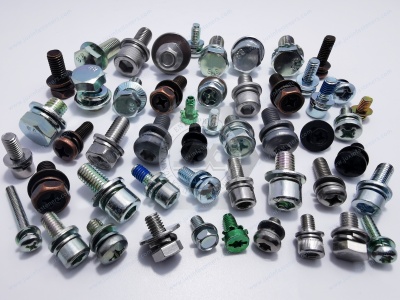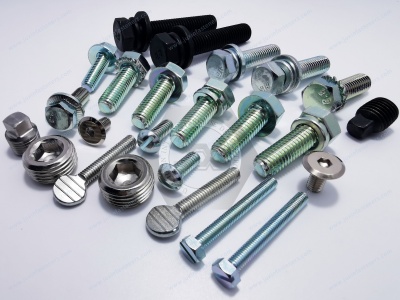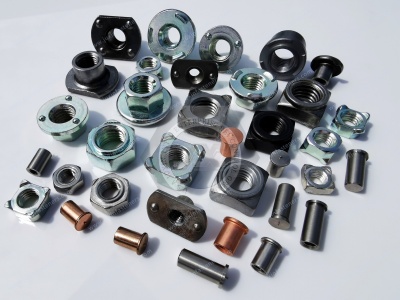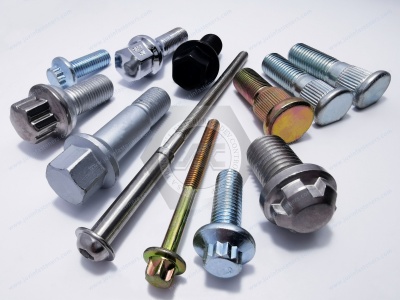Call Us
+86 136 6007 9809
Call Us
+86 136 6007 9809
Jun. 21, 2024
Automotive fasteners are commonly used material solutions.
The correct selection of fastener materials is an integral part of fastener manufacturing because the performance of fasteners and their materials are closely related. Suppose the material is not selected properly or correctly. In that case, it may cause the performance to fail to meet the requirements, shorten the service life, or even cause accidents or processing difficulties, manufacturing costs, etc. Therefore, the selection of fastener materials is an essential part.
Metal fastener materials are mainly steel. The type of steel used can be divided into cold pier steel, free-cutting steel, general stainless steel, heat-resistant steel, and high-temperature steel. There are many types of steel, but the number of grades is countless.
Based on the type of steel selected, the product characteristics of commonly used steels - cold heading steels, the common grades of steel, the international standards to which these grades of steel are subject, the types of fasteners they are suitable for and their performance levels, and the cold top forging test for cold heading steels.
1. Criteria and types of steel classification
No matter how complicated the material, the classification is inseparable from the logical hierarchy of the following chart; steel classification is also by this principle:
1) According to the classification of steel, according to the chemical composition classification standards: non-alloy steel, low-alloy steel, alloy steel.
Non-alloy steel carbon steel is also called carbon steel; carbon steel has a carbon content of 0.0218-2.11% (mass fraction) of the iron-carbon alloys to the carbon content of carbon steel is divided into high and low:
Low carbon steel: C% ≤ 0.25%; medium carbon steel: 0.25% < C% ≤ 0.6% and high carbon steel: C% ≥ 0.60%.
Carbon steel is alloyed with elements to adjust specific properties, and different alloy contents are divided into low-alloy steel and alloy steel.
Non-alloy, low, and alloy steel alloy elements specified content limit value can refer to the standard.
The bolt material is categorized into three types: carbon steel, carbon steel with added elements, and alloy steel.
Among them, carbon steel belongs to non-alloyed steel, and carbon steel with added elements belongs to the table of non-alloyed steel or low-alloyed steel according to the content of the added elements (boron, manganese, chromium).
The alloy steel should contain at least one of the four elements chromium Cr, nickel Ni, molybdenum Mo, and vanadium V, with a minimum content of chromium 0.30%, nickel 0.30%, molybdenum 0.10%, and vanadium 0.10%.
"When containing two, three or four composite alloying components, the content of alloying elements can not be less than 70% of the sum of the content of individual alloying elements", according to ISO898-1:2009, it should be: "When containing two, three or four composite alloying components, the two, three or four of these The sum of these two, three or four alloys shall not be less than 70% of the sum of the minimum contents of the corresponding two, three or four alloys.
For example, particular alloy steel containing chromium 0.2%, nickel 0.1%, then (0.2% + 0.1%) < (0.30% + 0.30%) × 70%, this steel is not alloy steel.
(2) According to GB/T 13304.2 steel classification, according to the leading quality level and the central performance or use of characteristics of the classification:
a) According to the leading quality level, ordinary quality, high quality, and exceptional quality non-alloy steel; ordinary quality, high quality, and extraordinary quality low-alloy steel; and high quality and special quality alloy steel.
b) By central performance or use characteristics - partial summary.


2. Characteristics, chemical composition, everyday standards, and classification of cold-heading steel
The main manufacturing processes for fasteners are cold heading (bolts, nuts, and other products) and stamping (reed fasteners, gaskets, etc.).
The raw materials are mainly hot-rolled coil and hot-rolled steel strips for cold heading.
a) Since cold heading steel is formed by plastic processing of metal at room temperature, the deformation of each part is substantial, and the deformation rate is high.
Fastener industry with "no cracking, quenching on" 6 sub describes the quality standard of cold heading steel. Therefore, the cold-heading steel raw material performance requirements are stringent, and the content of all elements must meet the material requirements' fastener performance level.
If the carbon C content is too high, cold-forming performance will be reduced; it is too low to meet the parts' mparts'cal properties requirements. Manganese Mn can improve the permeability of steel, but adding too much will strengthen the matrix organization and affect the cold-forming performance. In the parts of the tempering tendency to promote the growth of austenitic grains.
Silicon Si can strengthen the ferrite, prompting a reduction in cold-forming properties and material elongation.
Sulfur S and phosphorus P for impurity elements, their presence along the grain boundaries produce segregation, resulting in grain boundary embrittlement and damage to the mechanical properties of steel, should be reduced as far as possible.
Boron B element has a significant increase in the permeability of steel and other effects, but at the same time, it will lead to an increase in the brittleness of steel. Excessive boron content is detrimental to bolts, screws, and studs, which require a good combination of mechanical properties.
Alloy steels should contain at least one chromium Cr, nickel Ni, molybdenum Mo, and vanadium V element.
Chromium significantly improves steel's steel and oxidation resistance, modulates wear resistance, and maintains high-temperature strength. It can also increase the carbon content of the carburized layer and improve steel's stability.
Nickel: improve the strength of steel without reducing its plasticity, improve the low-temperature toughness of steel, so that the steel has excellent cold, hot workability and cold forming properties; reduce the critical cooling rate of steel, improve the hardenability of steel.
Molybdenum: strengthens ferrite, improves steel's steel's hardness, reduces steel's cooling rate, and improves steel's steerability. Improves heat resistance and high-temperature strength of steel.
Vanadium Refines grain size and increases toughness. It improves steel's temperature endurance and creep resistance and regulates its hardenability.
b) Commonly used standards for cold heading steels
ISO 4954 "Cold he"ding and cold extrusion steel
GB/T6478 Steel for Cold Heading and Cold Extrusion
GB/T28906 Hot Rolled Coil for Cold-Heading Steel
GB/T5953 Cold heading steel wire
Q/BQB517 Cold heading steel coil-Baosteel
JIS G3507 Carbon Steel Coil for Cold Heading Steel-Japan
JIS G4051 Carbon Steel for Mechanical Manufacturing-Japan
JIS G4053 Alloy Steel for Mechanical Manufacturing-Japan
SAE J403 "Chemica" Composition of Carbon Steels"-USA
SA" J404 "Chemica" Composition of Carbon Steels"-USA
SA" J404 "Chemica" Composition of Carbon Steels"-USA
DI" 1654 "Cold he" ding and cold extrusion steels" - Germ" NY
c) According to "Steel f"r Cold Heading and Cold Extrusion," and by"international standards and domestic general rules, there are four types of cold heading steel according to heat treatment:
1) Non-heat-treated type: Fasteners are not required to be heat-treated after cold-heading and forming. The finished processing grade is 4.6-6.8.
(2) surface hardening type: fasteners must be formed after cold pier surface carburizing (nitriding), quenching, and low-temperature tempering treatment. Finished products are mainly self-tapping nails and self-drilling screws.
(3) tempered (including boron steel): fasteners cold pier molding, first normalized and then quenched and high-temperature tempering treatment, or directly quenching and high-temperature tempering treatment. The finished grade of processing is 8.8-12.9 grade.
(4) Non-quenched type: There is no need for tempering heat treatment, so adding trace alloying elements in the steel so that the rolled or forged state has good overall mechanical properties can reduce the quenching and tempering process—finished products processed concerning fine-grain non-quenched steel bolts, screws, and studs mechanical grade 8.8F-10.F.
High-Temperature Alloy Steel Socket Head Screws—Grade B7:These screws are specially tempered to meet ASTM A193 specifications for temperatures up to 1100° F. They can be used in high-pressure applications. Length is measured from under the head.
Coarse threads are the industry standard; choose these screws if you don't know the thrdon'tper inch. Fine threads are closely spaced to prevent loosening from vibration. They are not compatible with coarse threads.
Medium-Strength Metric Class 8.8 Steel Hex Head Screws: These Class 8.8 steel screws are suitable for fastening most machinery and equipment. Dimensions meet ISO (formerly DIN) or DIN specifications. Length is measured from under the head.
Zinc-plated steel screws resist corrosion in wet environments. Black corrosion-resistant-coated steel screws resist chemicals and withstand 1,000 hours of salt spray. To maintain corrosion resistance, use these screws with black ultra-corrosion-resistant-coated nuts and washers.
Match the thread spacing of mating components. Coarse threads are the industry standard; choose these screws if you don't know the pitdon'tine, and extra-fine threads are closely spaced to prevent loosening from vibration; the finer the thread, the better the resistance.
Screws that meet SAE J1199 comply with specifications for material standards.
3. Common types of steel
a) SWRCH=steel wire (rod) for cold heading=carbon steel wire for cold forging, is a Japanese grade of steel in JIS G3507-2010 and Q/BQB517-2018 have the provisions of the grade and chemical composition.
SWRCH6A and SWRCH8A are suitable for producing standard and non-standard parts of grades 3.6-4.6.
SWRCH10A is suitable for producing 4.8-6.8 grade standard and non-standard parts.
SWRCH15A is suitable for producing all kinds of 4.8-6.8 grade fasteners and welding nails.
SWRCH18A and SWRCH22A are suitable for producing various medium—and high-strength self-tapping nails and standard 8.8-10.9 grade parts.
SWRCH35K, SWRCH40K, and SWRCH45K are suitable for producing 8.8-10.9 grade bolts and nuts.
Take SWRCH18A as an example, the meaning of letters and numbers:
S - carbon steel, WR - wire rod, CH - cold forging steel, 18 - average carbon content of 0.18%, A - deoxidation method, aluminum ballast steel; ballast steel is completely deoxidized steel, the oxygen mass fraction does not exceed 0.01%.
This numbering is the Japanese standard numbering, using SWRCH35K as an example of the meaning of letters and numbers:
S-Carbon steel, WR-Wire rod, CH-Cold forged steel, 35-Average carbon content 0.35%, K-Deoxygenation method, Silicon Aluminum ballast steel.
b) SCM435 and SCM440H are Japanese standard JIS G4053 alloy steels for machinery manufacturing, stipulated in Q/BQB517-2018. They correspond to domestic steels 35CrMo and 42CrMo.
SCM435 and SCM440H are commonly used steel grades for producing high-strength grade 10.9-12.9 fasteners, which are suitable for producing grade 10.9-12.9 bolts and nuts.
This numbering is the Japanese standard numbering. Take SCM440H as an example of the meaning of letters and numbers:
SCM-Chromium-Molybdenum steel: S-Steel steel, C-Cr chromium, M-Mo molybdenum, 4-Molybdenum content of about 4%, 40-Carbon content of about 0.40% up and down, H-guaranteed hardenability steel.
c) ML20MnTiB is a commonly used steel grade for producing Grade 10.9 steel structure standard parts, suitable for producing Grade 10.9 steel structure bolts of various types.
ML is the initial of rivet screw steel. ML is the initial of rivet screw steel, which is specified in "Steel for Cold Heading and Cold Extras" on."
This number is the national standard "number, ML - cold pier riveting screw steel, take riveting screw initials in hanyu pinyin, 20 - average carbon content of 0.20%, Mn - Manganese, Ti-Titanium, B-Boron, three alloys is less than 1.5%.
d) 10B21, 10B28, and 10B33 are suitable for producing fasteners from 8.8 to 10.9, mainly used for making standard parts from 8.8 to 10.9.
There are provisions in SAE J403-2014, "Chemical Composition of Carbon Steel," and Q/BQB517-2"18.
This numbering is the American standard number, 10 - carbon steel, B - boron steel, 21 - average carbon content of 0.21%.
e) ML35 is suitable for producing Grade 8.8 bolts, nuts, flange bolts, hexagonal bolts, etc.
It conforms to the specification of GB/T6478, "Steel for Cold Heading and Extrusion," and is equivalent to SWRCH35K.
f) 35VB is an alloy "structural steel, which is the steel grade for producing high-grade 10.9-grade steel structure bolts.
g) SCr420 and SCr440 are steel grades for producing high-strength fasteners of grade 12.9. They are alloy steels for manufacturing machinery in Japanese standard JIS G4053, also specified in Q/BQB517-2018.
h) 70 steel, 65Mn, 60Si2Mn are suitable for the manufacture of elastic washer fasteners, and Q235B No. 35 and No. 45 steel are high-quality carbon steels, which can be used for the manufacture of flat washers with different hardness requirements


4. Fastener material cold pier test
The cold pier (cold top forging, flattening) test is one of the most critical indicators of cold pier steel.
General requirements for hexagonal bolts should ensure that 1/2H test qualified, nuts and flange bolts and non-standard parts must ensure that 1/3H test qualified.
Cold pier test implementation YB/T5293 "metal materials top forging test method."
For high-quality Alloy Steel" Screws fasteners and professional techni"al support, don't hesitate to co don't us at adelajonly@gmail.com or visit our websdon'tt [Juxin Fastenedon'thttps://www.juxinfasteners.com.
Contact Us
Tel.:
+86 020 8621 0320
+86 020 3121 6067
Technical Support:
Navigation
SEND INQUIREY